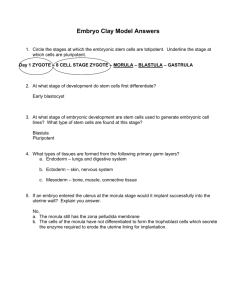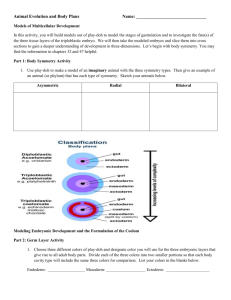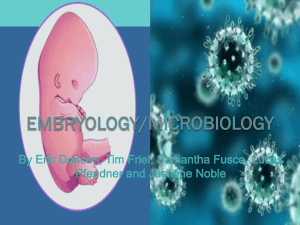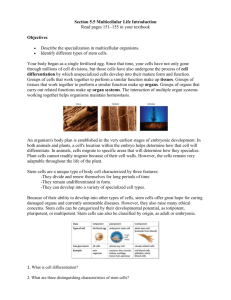StemCells Modeling Activity - Merrillville Community School
advertisement
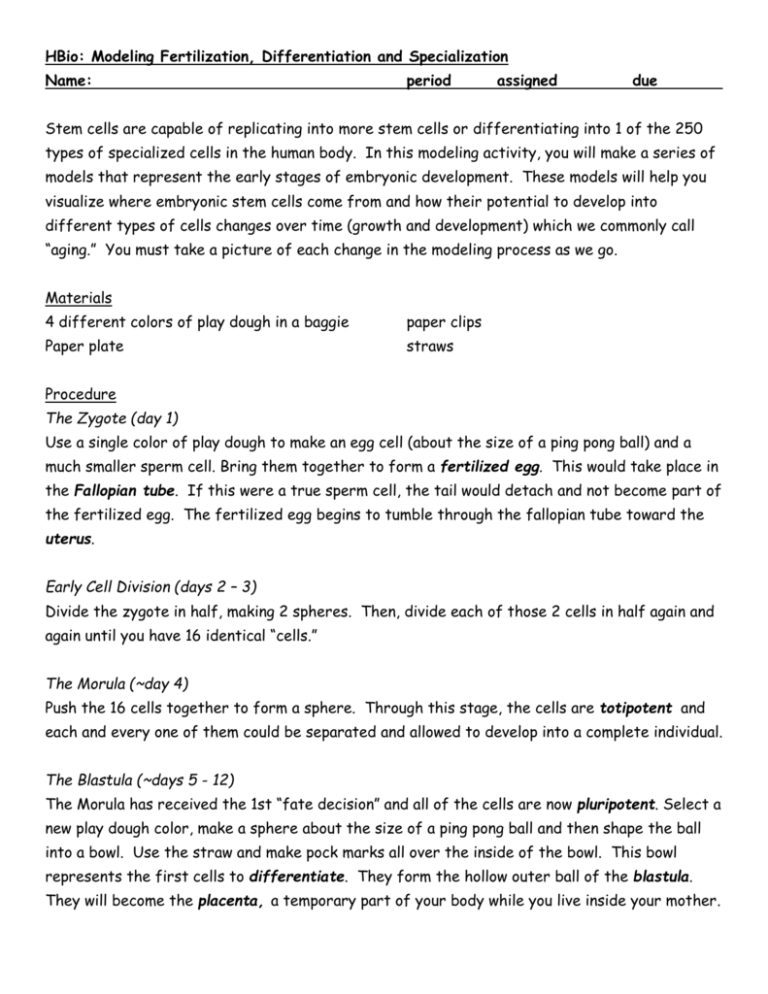
HBio: Modeling Fertilization, Differentiation and Specialization Name: period assigned due Stem cells are capable of replicating into more stem cells or differentiating into 1 of the 250 types of specialized cells in the human body. In this modeling activity, you will make a series of models that represent the early stages of embryonic development. These models will help you visualize where embryonic stem cells come from and how their potential to develop into different types of cells changes over time (growth and development) which we commonly call “aging.” You must take a picture of each change in the modeling process as we go. Materials 4 different colors of play dough in a baggie paper clips Paper plate straws Procedure The Zygote (day 1) Use a single color of play dough to make an egg cell (about the size of a ping pong ball) and a much smaller sperm cell. Bring them together to form a fertilized egg. This would take place in the Fallopian tube. If this were a true sperm cell, the tail would detach and not become part of the fertilized egg. The fertilized egg begins to tumble through the fallopian tube toward the uterus. Early Cell Division (days 2 – 3) Divide the zygote in half, making 2 spheres. Then, divide each of those 2 cells in half again and again until you have 16 identical “cells.” The Morula (~day 4) Push the 16 cells together to form a sphere. Through this stage, the cells are totipotent and each and every one of them could be separated and allowed to develop into a complete individual. The Blastula (~days 5 - 12) The Morula has received the 1st “fate decision” and all of the cells are now pluripotent. Select a new play dough color, make a sphere about the size of a ping pong ball and then shape the ball into a bowl. Use the straw and make pock marks all over the inside of the bowl. This bowl represents the first cells to differentiate. They form the hollow outer ball of the blastula. They will become the placenta, a temporary part of your body while you live inside your mother. Using your original color of play dough, make many pea sized spheres to represent the cells growing and dividing inside of the hollow ball. This mass of cells is referred to as the inner mass or the embryonic stem cells. These cells have only gone through one “fate decision.” The cells that make the hollow ball can now only become the placenta and the cells of the inner mass can become any other type of human cell EXCEPT placenta. At this point, an embryonic stem cell line could be made by plucking cells from the inner cell mass to a culture dish and growing them in material that provides the proper support and nutrients. You have made it to the uterus and begin to implant yourself in the nutritious lining. The Gastrula Make another placenta bowl in the same color as the original. Make another pea sized ball of the original color & set it aside. Take a 3rd color about the size of a large marble and flatten it. Wrap this around the pea sized ball. Do this one more time with the 4th color. Now, take the paper clip and cut the final 3 layered ball in half. Place 1 half in the bowl connected to the side somewhere. This is the gastrula with cells that are multipotent. Each layer receives a 2nd “fate decision” and is either the endoderm, the mesoderm or the ectoderm. Each of these layers continues to differentiate and the cells are now called adult stem cells. 1. Use your camera to take separate pictures of each model. Create a prezi or powerpoint, and label: zygote, morula, blastula, gastrula, placenta, inner cell mass, embryonic stem cells, adult stem cells, fallopian tube, uterus, uterine lining, totipotent, multipotent, pluripotent 2. Explain how colored clays were used to help the differentiation model. 3. According to your model, did the size of the developing embryo increase, decrease or stay the same? 4. According to your model, did the overall number of cells increase, decrease or stay the same? 5. Research what organs and systems will continue to differentiate and specialize for the ectoderm, the mesoderm and the endoderm. Create a table to record your research. 6. Create a basic timeline of trimester 1 (try visembryo.com) 7. What characteristic(s) of life are evident in trimester 1? What is your evidence? 8. Describe how trimester 1 is different from what occurs during trimesters 2 and 3.
